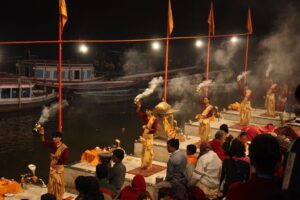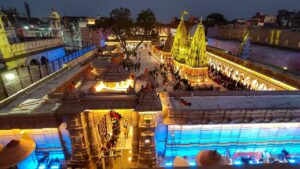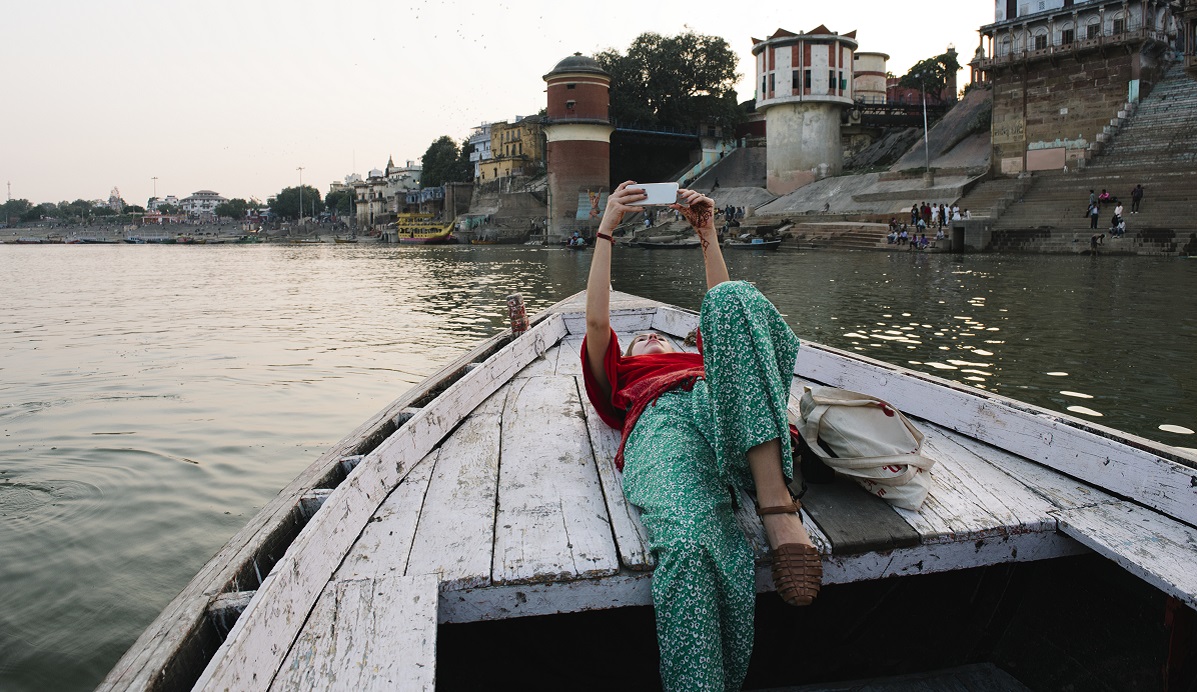Varanasi is a city that should not be missed in anyone’s travel itinerary. It is an ancient city with plenty of sights, sounds, and experiences to take in. With a 2-day itinerary you can make sure you are taking in all of the important aspects of the city. You can tour the ghats, explore the temples and visit the old city. You can also take in the unique culture of the city, with its colorful street markets and vibrant nightlife. With a 2-day itinerary you can also ensure you can watch a beautiful sunset over the ghats and witness the evening aarti ceremony. A 2-day itinerary in Varanasi is sure to provide a unique and unforgettable experience.
Table of Contents
- Overview of Varanasi as a destination
- I). Day-1
- Morning: Boat Ride on the Ganges River
- Best time to go
- Tips For Visiting
- Afternoon: Visit to Sarnath
- Places to visit in Sarnath
- Tips for visiting
- Evening: Aarti ceremony at Dashashwamedh Ghat
- Tips For Experiencing the Ganga Arti
- II). Day 2
- Morning: Visit to Kashi Vishwanath Temple
- Tips for Visiting
- Afternoon: Explore the narrow lanes of Varanasi
- Best Areas to Explore
- Tips for Best experience of Gali
- Evening: Shopping in Varanasi
- Tips for bargaining
- Conclusion – Recap of The Itinerary
- Additional recommendations for experiencing Varanasi
- Final thoughts and tips for visiting the city.
Overview of Varanasi as a destination
In the overview of Varanasi as a destination, you would provide an introduction to the city and its significance. Varanasi, also known as Banaras or Kashi, is a city located in the northern Indian state of Uttar Pradesh. It is considered one of the oldest continuously inhabited cities in the world, and is an important pilgrimage site for Hindus. The city is situated on the banks of the Ganges River and is known for its religious and spiritual significance, as well as its rich cultural heritage. Visitors can experience the city’s rich history and culture through its many temples, ghats (stairs leading down to the river), and narrow lanes, as well as by participating in traditional rituals and ceremonies.
I). Day-1
Morning: Boat Ride on the Ganges River

The Ganges is one of India’s most important rivers and is a great way to experience and explore Varanasi. A morning boat ride on the river is a special experience, especially at sunrise. The ride is a great opportunity to take in the sights and sounds of the city, taking in its ancient ghats, temples, and palaces from the unique vantage point of the river. Along the way, you can also spot wildlife such as birds and monkeys that inhabit the riverbanks. Make sure to bring your camera and take lots of photos of the incredible scenery. A morning boat ride is an unforgettable experience that you will want to savour.
Best time to go
It is best to take the ride in the early morning when the waters are calm and the sun is rising. You can observe the activities of the locals and the pious rituals that they perform in the river. The best time to take the boat ride is during sunrise and sunset, when the water reflects off the red of the setting sun and creates a stunningly beautiful view. You will also get to see a lot of local birds and other wildlife around the riverbanks.
Tips For Visiting
- Go early in the morning: The best time to take a boat ride is early in the morning when the river is calm and the air is cool.
- Respect local customs: Visitors should be mindful of local customs and traditions while on the boat ride, such as not pointing their feet at or touching religious artifacts or statues.
- Hire a private boat: If you want to avoid the crowds, consider hiring a private boat for a more peaceful and intimate experience.
- Take a camera: The views of the city and the ghats from the river are stunning, so don’t forget to take a camera to capture the memories.
- Respect the river: the Ganges river is considered holy and sacred, so visitors should avoid throwing trash or pollution into the river.
Afternoon: Visit to Sarnath

Sarnath is an important Buddhist pilgrimage site located in the city of Varanasi. It is believed to be the place where the Buddha gave his first sermon after attaining enlightenment. Sarnath is home to several important Buddhist monuments, including the Dhamek Stupa, which is believed to mark the spot where the Buddha delivered his first sermon, and the Chaukhandi stupa, which marks the spot where the Buddha’s followers first met him after his enlightenment. The Sarnath Museum, which houses many important Buddhist artifacts, is also located in the area. Visitors can also find many temples and monasteries in Sarnath, including the Mulagandhakuti Vihara, which is believed to be the site where the Buddha meditated.
Places to visit in Sarnath
There are several important places to visit for those interested in its rich history and cultural significance. Some of the must-see places in Sarnath include:
- Dhamek Stupa: This is one of the most important monuments in Sarnath and is believed to mark the spot where the Buddha gave his first sermon. The stupa is an impressive structure and is considered one of the oldest stone structures in India.
- Chaukhandi stupa: This is another important monument in Sarnath, which marks the spot where the Buddha’s followers first met him after his enlightenment. It is a brick stupa and dates back to the Gupta period.
- The Sarnath Museum: This museum houses a collection of important Buddhist artifacts including sculptures, inscriptions, and architectural fragments.
- The Mulagandhakuti Vihara: This temple is believed to be the site where the Buddha meditated, and is considered one of the most sacred temples in Sarnath.
- Ashoka Pillar: The Ashoka pillar is a historic pillar dating back to the 3rd century BCE, it bears an inscription of Emperor Ashoka and is considered one of the most important archaeological finds in Sarnath.
- The Chinese Temple and Thai Temple: these temples were built by the Chinese and Thai monks, they showcase the different architectural styles and influences of Buddhism in Sarnath.
- The Deer Park: The Deer Park is where the Buddha first taught the Dharma and where the first Sangha was formed. It is considered a sacred spot for Buddhists.
- Excavated ruins: Sarnath has a lot of excavated ruins, which provides a glimpse of the rich history and heritage of the place.
Tips for visiting
- Go early in the morning: To avoid the crowds and the heat of the day, it’s best to visit Sarnath early in the morning.
- Visit the Sarnath Museum: The Sarnath Museum is home to many important Buddhist artifacts and provides an in-depth understanding of the history and significance of the area.
- Hire a guide: To fully understand the historical and religious significance of the various monuments in Sarnath, it’s a good idea to hire a guide.
- Take a camera: Sarnath has several beautiful and historically significant monuments, so don’t forget to bring a camera to capture the memories.
- Respect local customs: Visitors should be mindful of local customs and traditions while at Sarnath, and avoid pointing their feet at or touching religious artifacts or statues.
- Take time to meditate: Sarnath is a place of spiritual significance, so take some time to sit quietly, meditate and reflect on the teachings of Buddha.
Evening: Aarti ceremony at Dashashwamedh Ghat

The Aarti ceremony at Dashashwamedh Ghat is considered one of the most important and spectacular ceremonies in Varanasi and is a must-see for visitors. It is an excellent opportunity to witness the spiritual and cultural significance of the city and the Ganges River.
The Aarti ceremony at Dashashwamedh Ghat is a Hindu religious ritual that takes place every evening on the banks of the Ganges River in Varanasi. It is a spectacular event that involves the lighting of lamps and the offering of prayers to the river and the deities associated with it. The ceremony is performed by Hindu priests and is accompanied by music and the recitation of mantras. During the ceremony, a large number of small clay lamps are floated on the river as a symbol of the offering of light to the gods.
Best time to attend: Evening 6- 8 PM
Tips For Experiencing the Ganga Arti
- Arrive early: To get a good spot to watch the ceremony and avoid the crowds, it’s best to arrive early.
- Be mindful of local customs and traditions: Visitors should be mindful of local customs and traditions and show respect to the participants and the ceremony.
- Take a camera: The Aarti ceremony is a spectacular event, so don’t forget to bring a camera to capture the memories.
- Be respectful: The Aarti ceremony is an important religious ritual, so it is important to be respectful and avoid disturbing the ceremony in any way.
- Listen to the chants and mantras: The ceremony is accompanied by traditional music and the recitation of mantras, which is an important aspect of the ritual, it’s worth listening to it and try to understand the meaning.
- Don’t miss the final Aarti: The final Aarti is the most spectacular part of the ceremony, where the priests light a large number of small clay lamps and float them on the river, don’t miss it.
II). Day 2
Morning: Visit to Kashi Vishwanath Temple

Kashi Vishwanath Temple is one of the most important and sacred temples in the city of Varanasi. It is dedicated to Lord Shiva, one of the principal deities in Hinduism and is considered one of the most important pilgrimage sites for Shaivites. The temple has a rich history and is believed to have been built by the famous Maratha king, Raja Todarmal, in the 16th century. However, it is said that the temple has stood on the site for thousands of years and has been destroyed and rebuilt several times over the centuries.
The temple is known for its golden spire and the Shivalinga, which is the main object of worship. It is also believed that a visit to the Kashi Vishwanath Temple, also known as the “Golden Temple” will grant salvation and liberation from the cycle of birth and death.
Tips for Visiting
- Go early in the morning: To avoid the crowds and the heat of the day, it’s best to visit the temple early in the morning.
- Be prepared for security check: Security check is mandatory before entering the temple, so be prepared for it.
- Be respectful: The Kashi Vishwanath Temple is an important religious site, so it is important to be respectful and avoid disturbing the temple in any way.
- Avoid peak hours: The temple is always crowded, try to avoid the peak hours like evening and weekends to avoid the crowd.
- Avoid taking leather items: Leather items are not allowed inside the temple, so avoid taking them with you.
Afternoon: Explore the narrow lanes of Varanasi

Exploring the narrow lanes of Varanasi is an excellent way to experience the city’s rich culture and heritage. The narrow lanes, also known as “galis” are lined with small shops, temples, and homes, and offer a glimpse into the everyday life of the city. Visitors can find a wide variety of items for sale in the shops, including silk saris, brassware, and traditional sweets. The lanes are also home to many traditional craftsmen, such as weavers and potters, who practise their craft in small workshops.
Best Areas to Explore
- Vishwanath Gali: This gali is located near the Kashi Vishwanath Temple and is known for its many shops selling traditional silk saris and brassware.
- Godaulia: This gali is located near the Dashashwamedh Ghat and is known for its many shops selling traditional sweets and snacks.
- Chowk: This area is known for its many small shops selling a variety of items, including traditional handicrafts and souvenirs.
- Bhikharipura: This gali is known for its many traditional weavers and silk merchants. Visitors can see the weavers at work and purchase traditional silk saris.
- Raja Bazaar: This gali is known for its many shops selling traditional musical instruments, such as sitars and tablas.
- Bazaar Kedar: This gali is known for its many shops selling traditional perfumes, incense, and other spiritual items.
- Chhoti Gwaltoli: This gali is known for its many traditional potters, who practice their craft in small workshops. Visitors can see the potters at work and purchase their traditional pottery.
Tips for Best experience of Gali
One of the best ways to explore the narrow lanes of Varanasi is to take a walking tour, which will give you the opportunity to see the city up close and personal and to interact with the locals. Some of the most popular areas to explore include the lanes around the Kashi Vishwanath Temple and the Dashashwamedh Ghat, as well as the area around the Chowk and Godaulia.
Exploring the narrow lanes of Varanasi is an excellent way to experience the city’s rich culture and heritage and to get a sense of the everyday life of the locals. It’s also an opportunity to find unique souvenirs and to witness traditional craftsmen at work.
Evening: Shopping in Varanasi

Varanasi is a great place to shop for traditional Indian handicrafts, silk saris, and other unique items. Some of the best places to shop in Varanasi include:
- Vishwanath Gali: This gali is located near the Kashi Vishwanath Temple and is known for its many shops selling traditional silk saris and brassware.
- Godaulia: This gali is located near the Dashashwamedh Ghat and is known for its many shops selling traditional sweets and snacks.
- Chowk: This area is known for its many small shops selling a variety of items, including traditional handicrafts and souvenirs.
- Bhikharipura: This gali is known for its many traditional weavers and silk merchants. Visitors can see the weavers at work and purchase traditional silk saris.
- Raja Bazaar: This gali is known for its many shops selling traditional musical instruments, such as sitars and tablas.
- Bazaar Kedar: This gali is known for its many shops selling traditional perfumes, incense, and other spiritual items.
- Chhoti Gwaltoli: This gali is known for its many traditional potters, who practice their craft in small workshops. Visitors can see the potters at work and purchase their traditional pottery.
Tips for bargaining
When shopping in Varanasi, bargaining is a common practice and is expected by most shopkeepers. Here are some tips for bargaining in Varanasi:
- Research prices: Before you go shopping, research the prices of the items you’re interested in buying, so you have an idea of what the fair price should be.
- Start low: When bargaining, start with a low offer and work your way up.
- Be friendly: Bargaining can be more successful when both parties are friendly and in good spirits.
- Be confident: Show confidence when bargaining and be willing to walk away if the price is not to your satisfaction.
- Be respectful: Remember to be respectful and polite when bargaining, even if you don’t agree on the price.
- Be willing to compromise: Be willing to compromise, find a middle ground and make a deal that is beneficial for both parties
- Don’t be afraid to walk away: If you don’t agree on the price, don’t be afraid to walk away and look for a better deal elsewhere.
- Be mindful of the local culture: Remember that bargaining is a part of the local culture, and it’s considered a normal practice, so don’t take it as an offence.
Conclusion – Recap of The Itinerary
The 2-day itinerary for Varanasi includes a boat ride on the Ganges River to witness the sunrise and the famous Ganga Aarti ceremony at Dashashwamedh Ghat. Visit the historical sites such as the Sarnath, where Buddha gave his first sermon, and the Kashi Vishwanath Temple, one of the most sacred temples in the city. Explore the narrow lanes of Varanasi to see the traditional craftsmen at work and purchase traditional silk saris and brassware. Don’t miss the chance to witness the rich culture and heritage of the city, dress modestly, respect local customs and take a guide to fully understand the significance of the places.
Additional recommendations for experiencing Varanasi
In addition to the itinerary, visitors to Varanasi should also consider visiting other notable sites such as the Ramnagar Fort, the Manikarnika Ghat, and the Bharat Mata Temple. These places offer a glimpse into the rich history and cultural heritage of Varanasi. Visitors should also try local street food and sweets, such as lassi, chaat, and kulfi. Additionally, visitors should also consider taking a cooking class to learn about traditional Indian cuisine. Yoga and meditation classes are also available for those interested in experiencing the spiritual side of Varanasi. Consider taking a guided tour to fully understand the significance of these places and activities.
Final thoughts and tips for visiting the city.
In conclusion, Varanasi is a unique and fascinating city with a rich cultural and spiritual heritage. Visitors should make the most of their time by following the 2-day itinerary, visiting the recommended sites, and trying local food. They should also be respectful of local customs and dress modestly. Hiring a guide is highly recommended to fully understand the significance of the places visited. Visitors should also be prepared for the heat, traffic, and crowds and be mindful of their belongings. To truly experience the city, visitors should keep an open mind and embrace the unique atmosphere and culture of Varanasi.












